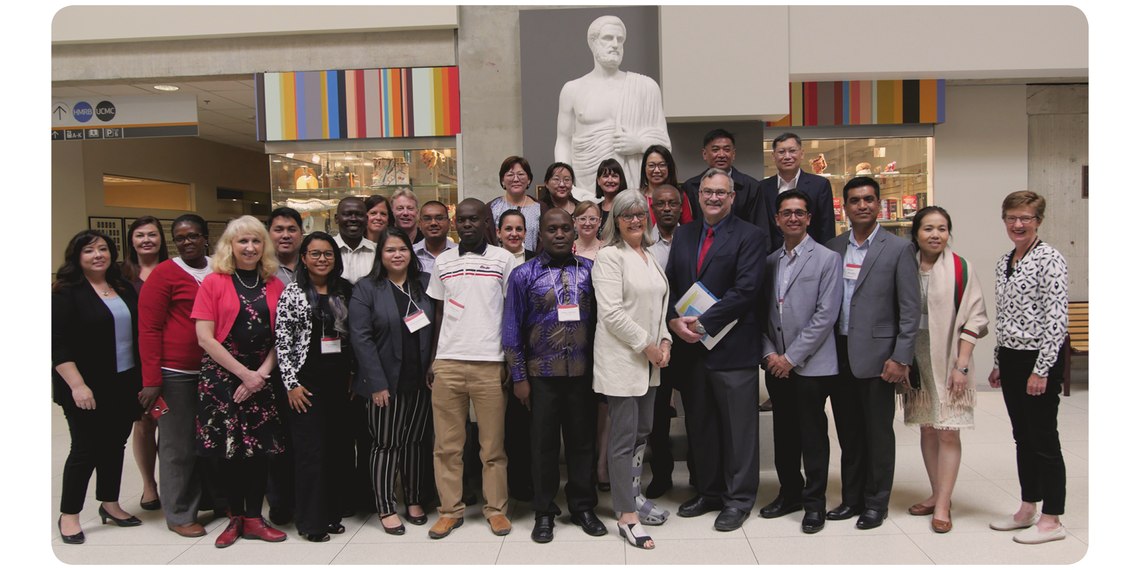Oct. 22, 2018
Improving medical education and research around the world

The Cumming School of Medicine (CSM) students and faculty travel the world, seeking to improve medical education and health outcomes, particularly in low and middle income countries.
In 2018, the model was reversed. The CSM brought leaders of medical education from universities in low and middle income countries to Calgary for an international institute on medical education.
“Until now, the model has been the CSM faculty travel to them,” says Dr. Heather Baxter, MD, lead of International Medical Education Capacity Building, referring to the CSM’s long history of partnerships with medical schools across the globe. Baxter co-organized the project with Dr. Gwendolyn Hollaar, MD, assistant dean of Global Health Education Development.
Nineteen participants from eight different countries were invited for presentations from faculty including classroom lectures and workshops on effective lecturing, curriculum design, educational leadership; site visits to lecture rooms and labs within UCalgary’s Foothills campus; and in-person consultations with the CSM faculty.
They also visited a pediatric simulation lab at the Alberta Children’s Hospital. The goal is to develop local champions within partner universities who can lead improvements in medical education at their institutions.
“The information I gather in Calgary is going to help improve the medical education program in Guyana,” says participant Dr. Ronald Aaron, MD, director of the School of Medicine at the University of Guyana.
“Some people in our community live a nomadic lifestyle, which can bring unique nutrition and health challenges. I will use the information (from the institute) to help prepare doctors in Mongolia to provide nutritional and lifestyle advice,” says Dr. Enkhtuya Vankhuu, PhD, a director with the Mongolian National University of Medical Sciences.
The CSM partners with several international universities to collaborate on improving medical science teaching and learning internationally.
“There is a tremendous benefit to the university and our students and staff from these partnerships,” says Hollaar. “It helps our students become better doctors and offers an incredible experience in social responsibility. It also supports the university’s ability to attract the best students and faculty by demonstrating global leadership in health training and research.”
Where did participants come from?
- Catholic University of Health and Allied Sciences – Tanzania
- Mbarara University of Science and Technology – Uganda
- Autonomous University of Nicaragua
- University of Guyana, School of Medicine
- Ateneo de Zamboanga School of Medicine – Philippines
- University of Health Sciences, LAOS PDR
- Patan Academy of Health Sciences – Nepal
- Mongolian National University of Medical Sciences
Funding to cover airfare, accommodation and other small expenses was provided by the Samuel T. McLaughlin Travelling Medical Education Fund, a UCalgary international development grant and a private donation.

A lasting impact in Zamboanga
The CSM is celebrating the silver anniversary of its partnership with the Ateneo de Zamboanga University School of Medicine, located in southwestern Philippines.
For 25 years, CSM students and faculty have been working in Zamboanga to support the medical school’s development, including a Masters in Public Health, other postgraduate training and medical faculty capacity building.
Over the years, the partnership has also allowed medical specialists and educators from the region to study at the CSM, upgrading skills in areas such as heart failure management, oncology and clinical examination before returning to teach new skills back home.
Students and faculty at the CSM have supported humanitarian efforts in the impoverished region, such as helping improve access to potable water for a nearby village of approximately 250 people. The project was also supported by the Rotary Club of Calgary.
The partnership has contributed to improving public health in the region. Infant mortality rates have been reduced from 75-80 out of 1,000 live births in 1995 to 5-8 out of 1,000 live births in 2008.
“When we began, the proposed medical school had few resources. It had no curriculum, no classrooms, no library and no one with experience managing a medical training program. Criteria for selecting students had not been developed,” says Dr. Clarence Guenter, MD, professor emeritus at the CSM who helped establish the partnership. “We had a highly motivated group of physicians that were willing to learn and teach, and community leaders who believed in their potential to improve lives. Today we have one of the longest ongoing collaborations at the CSM and improved health outcomes help demonstrate the value of our partnership every day.”



